Lynn Austin's Blog, page 2
July 6, 2023
Have a Memorable Vacation–Maybe?
“Tell us about a memorable summer vacation.” At a luncheon with my publishing company, recently, the sales team and I were asked to do just that. I heard about a lot of interesting vacations from the other team members, and as I awaited my turn, dozens of great memories came to mind. A tour through seven European countries with Ken and our kids. A bicycle trip around Europe’s Lake Konstance with our son, Ben. A road trip early in our marriage from Connecticut to Anchorage, Alaska. Camping on Cape Cod with my parents and two sisters. Long, lazy summer days at my grandparents’ home in Pennsylvania’s Pocono Mountains.
But the memorable vacation I settled on—and it had been the first one that popped into my mind—was a camping trip we took with our kids when they were young to visit some of America’s national parks. We lived in Canada at the time, and Ken had learned that if we bought a U.S. National Parks’ pass, we could visit all the parks for free. It was a bargain too good to pass up. We set off in our Toyota station wagon, pulling a borrowed “pop-up” tent trailer, and headed south and west, starting with Rocky Mountain National Park.

Hundreds of miles and many scenic wonders later, we arrived at the Grand Canyon in time to watch the sunset. Magnificent! Up until that time, we had been able to camp along the way without any trouble. But all the campsites at the Grand Canyon were full. It seems most people are wise enough to make reservations in advance. The Grand Canyon is in the middle of nowhere, so the only other campgrounds were a 2-hour drive back in the direction we had just traveled.

After a spirited discussion about our lack of planning, we decided to park the car and trailer in a parking lot behind one of the lodges for the night. Ominous signs are posted all over the park warning of stiff fines for camping anywhere except in designated sites, so we decided not to “pop-up” the pop-up. Technically, we would not be “camping.” So, we emptied the car and spent the night sleeping in our Toyota. Our two sons slept in the driver’s and front passenger’s seats, tilted back as far as they would go. We folded down the back seat, and Ken and I and our 6-year-old daughter slept in the back of the station wagon. I use the term “slept” very loosely. Throughout the night, I kept waiting for a park ranger to knock on the window and issue us a very expensive “no camping” ticket. My reply would have been, “Do we look like we’re camping?
But by morning, the entire parking lot was filled with vans, trailers, and motor homes. We weren’t the only ones who hadn’t made reservations. Our kids had slept quite well and were eager to begin exploring the park. Ken and I, on the other hand, were quite rumpled and disgruntled. At least we had drawn closer together as a family, I joked.
We visited many great national parks on that vacation and saw a lot of magnificent sights. When we returned home, I asked the kids what they remembered and liked the best, and guess what they said? “The night we slept in the car at the Grand Canyon.”
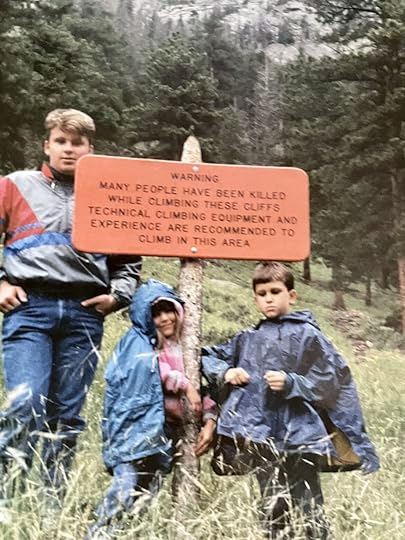
Isn’t life like that, though? A lot of days and weeks and months pass by when we do the same-old, same-old, and nothing seems particularly memorable. But it’s those challenging times when the unexpected happens that seem to make a much deeper impression. I spent hundreds of blissful summer days at my grandparents’ home in the Pennsylvania woods, but which one is most memorable? The dark night of torrential rain when the dam upriver threatened to break and we were forced to evacuate to higher ground. We sent up a lot of prayers that night!

I find that it’s in challenging times like that long-ago, rainy night that we draw closest to God and cling the hardest to Him. We can forget that we even need Him when the sun shines and everything goes according to plan. Perhaps that’s why He allows us to go through those wilderness times. Not only do we draw closer to Him, but we also learn important lessons about His power, and faithfulness, and love for us. We learn we can trust Him, and that makes the experience deeply memorable.
So, what’s your most memorable summer vacation?
I would wish you all a memorable summer vacation this year, but maybe you would rather have a quiet, uneventful one, instead.
The post Have a Memorable Vacation–Maybe? first appeared on Lynn Austin.
June 1, 2023
Welcome to the Family
The frigid January day was a memorable one for our family. With the final “bang” of the judge’s gavel, our son Joshua became Aiden’s father. My husband and I became Aiden’s grandparents. The court proceeding made it official, but we have loved this wonderful boy from the day we first met him and his amazing mom, Sara. Joshua had wanted to adopt Aiden ever since he and Sara married nearly two years ago, and the paperwork was finally complete. I had tears in my eyes as Joshua promised to support, raise, and love Aiden as his own son. The judge allowed Aiden to “bang” the gavel to complete the process. Welcome to our family, Aiden!
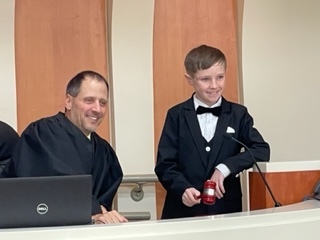
I have been reflecting on adoption a lot, lately. My upcoming novel, “All My Secrets,” includes the story of a woman who is forced to surrender her child for adoption. The novel takes place in New York City during the Gilded Age, a time when the very wealthy lived in excessive opulence—and the city’s orphanages overflowed with unwanted children of all ages. Some of these children had lost their parents due to their deaths, some were abandoned by them, and many were simply turned over by parents who were unable to support them. Many more unwanted children lived in the streets, surviving as best they could. In 1890, photographer Jacob Riis stirred the nation’s conscience when his book “How the Other Half Lives” published his heartbreaking photos. This is one of his famous ones.

After Aiden’s adoption, I also began noticing the theme in scripture. The Westminster Catechism says that “Adoption is an act of God’s free grace,” granting us “all the privileges of the sons of God.” Just as Aiden now has legal rights and privileges as Josh’s son, we have privileges as the children of the God. “For He chose us in Him before the creation of the world to be holy and blameless in His sight. In love, He predestined us to be adopted as His sons and daughters through Jesus Christ…” (Ephesians 1:4-5). I can’t take that in, can you? And the love our family feels for Aiden is just a fraction of the love God has for us.
Ken and I were excited to visit Aiden’s school on Grandparent’s Day. I’m thrilled when he calls me “Grandma.” And I believe God wants that same kind of loving relationship with us. Romans 8 says we “have received the Spirit of sonship. And by him we cry, Abba, Father. The Spirit himself testifies with our spirit that we are God’s children. Now if we are children, then we are heirs—heirs of God and co-heirs with Christ…” Aiden is now listed as an heir in our will. But I can barely conceive of the inheritance that is mine as a child of God!
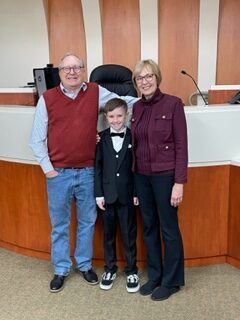
This Father’s Day will be Joshua’s first one as a dad. He paid the costs that were involved in Aiden’s adoption process—court fees, lawyer’s fees, and so on. But our adoption into God’s family cost Our Heavenly Father the greatest price of all—His son, Jesus. Can we even fathom the enormity of His love? As we remember and honor our earthly dads this year, I hope I can grasp the importance of our adoption by our loving Heavenly Father. Welcome to His family, child of God!
(One more thing: If you would like a sneak peek at the cover of “All My Secrets,” be sure to go to my website www.lynnaustin.org and subscribe to my monthly newsletter. I will be revealing the cover in June’s newsletter.)
The post Welcome to the Family first appeared on Lynn Austin.
May 1, 2023
Time For Tulips

There’s a lot of excitement in my hometown of Holland, Michigan these days. While winter and spring continue to arm-wrestle with each other, bringing seventy-degree temperatures one day and snow flurries three days later, our town is gearing up for the annual Tulip Festival. At the same time, film crews have taken over our famous tourist attraction, Windmill Island, so actress Nicole Kidman can shoot her new movie there. Everyone in town is hoping to catch a glimpse of her tiptoeing through the tulips.
I love the excitement of Tulip Time. The annual eight-day festival has been held, uninterrupted, for the past 92 years—except during Covid, of course. It draws hundreds of thousands of people to see the three parades, to watch Dutch dancers in costume, to attend the concerts and shows, to taste Dutch food, and to see the multicolored tulips. Over six million tulips, in fact, have been planted throughout Holland. It’s a grand celebration of the town and its history, founded by immigrants from the Netherlands in 1847.

I don’t have a Dutch bone in my body, but I came to Holland for the first time to study at Hope College, which is affiliated with the Reformed Church. The early Dutch settlers founded the college in 1862 with the symbol of an anchor, based on Hebrews 6:19: “We have this hope as an anchor for the soul, firm and secure.” As a college freshman, I was walking past the iconic anchor one day on my way to class when a couple who were obviously tourists stopped me. (You could always spot tourists back in those days by the cameras and lens cases dangling around their necks.) “Are you a Hope College student?” the husband asked. I was. “Would you mind posing for us in front of the anchor?” I agreed, and got into position (somewhat awkwardly, I’m sure) holding my books and notebooks.
Just as the husband was about to snap my picture, his wife interrupted. “Wait a minute! Wait a minute! Are you Dutch?” she asked me. I was not. “Never mind, then,” she said, shooing me away. “We want a Dutch girl.” I guess I missed my chance to play a starring role in someone’s scrapbook.
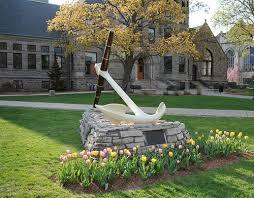
I was so intrigued by the town’s history that when my husband retired and we moved to Holland nine years ago, I decided to research the stories of the early settlers for a novel. Waves of Mercy was published in 2016 and is based on the memoirs of those first men and women. I was very surprised to learn why they left their homes and families in the Netherlands—a very civilized nation back in 1847—to settle in the forested wilderness of Michigan. It was because of religious persecution. As separatists from the state-sponsored church, they had faced heavy fines, harassment, and even imprisonment, simply for gathering to worship God. They braved the long ocean voyage and the hard work of taming the forest in order to seek the religious freedom that America offered.

Their nearest neighbors were a tribe of Ottawa Indians. The nearest town, Allegan, was twenty-four miles away, accessible only by foot. During their first summer here, numerous settlers died from malaria. They lived in lean-tos and one-room cabins, yet their faith was so important to them that they began building this beautiful church in 1854, a mere seven years after they arrived. The story of Holland’s first citizens is truly a story of perseverance, faith, and hope.

I was also surprised to learn that they didn’t settle in Holland in order to isolate themselves in a safe, exclusive community. Nor did they see themselves as missionaries with the goal of reaching the lost. They came as farmers and businessmen who wanted to serve Christ in their everyday work. They chose this location, perched on a small lake that feeds into Lake Michigan, because they wanted easy access to the developing nation’s waterways. This month the town celebrates their Dutch heritage, but Holland is also proud of the diverse cultures that call this town their home.
In a world that is increasingly divisive and often hostile toward Christianity, I sometimes long to hide away in my own little bubble of like-minded friends. Or else fight back by joining the chorus of angry voices on social media. What I’ve learned from Holland’s first settlers is that I am called to be a light in the darkness, a city shining on a hill. I practice my faith best when I leave the “holy huddle” to live and speak and interact with people around me in a way that brings glory to God.
From that first boatload of settlers, Holland has now grown to a town of 34,000 inhabitants. From that first church in the wilderness, the greater Holland area now has more than 170 churches. This plaque sums up what its founding father, Albertus Van Raalte had to say about the village of Holland:

The post Time For Tulips first appeared on Lynn Austin.
December 12, 2022
Immanuel
I spoke at a Christmas luncheon recently with a “White Christmas” theme, and since we were supposed to dress from the era, I borrowed a friend’s vintage mink stole and pillbox hat. It was so much fun to look back at the time period of that film, which premiered in 1954. World War II was finally over, there was peace on earth, and that boisterous generation of Baby Boomers was born. I was one of them.
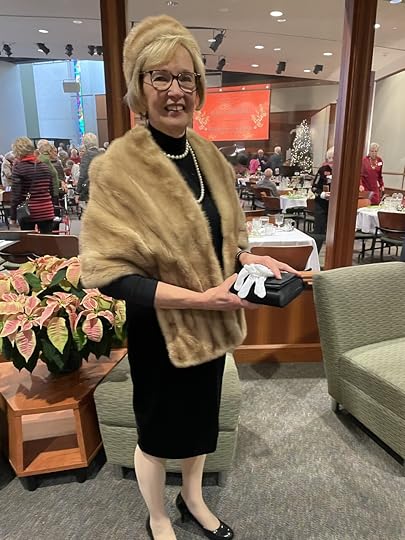 https://lynnaustin.org/2022/12/immanuel/
https://lynnaustin.org/2022/12/immanuel/When I was a girl, Christmas always meant going to church. The ladies wore hats and gloves, men wore suits and ties, and my sisters and I wore our very best dresses and patent-leather shoes. We would shine them with Vaseline and wear them beneath clumsy rubber galoshes as we walked through the snow.
The small town where I grew up had only two churches, and in those days, church attendance was normal and almost expected. We shared pews with many of our teachers, the school principal, the grocer and drug store owner – everyone we knew, it seemed. As children, we got to participate in the annual pageant, dressing up as shepherds, angels, wise men, or the coveted role of Jesus’s mother, Mary. Sadly, I was never selected to play Mary. On Christmas Eve there was a lovely candlelight service, and I remember gazing at the baby in the manger with wonder. It was such an amazing miracle—Immanuel! The God of the universe, and all of creation had come to be with us!

My parents never had much money, but my mom would open a Christmas Club account at the local bank, tucking away a small amount of money each week so she could buy presents. We always had a scrawny Christmas tree, decorated with colored balls and bubble lights shaped like little candles. And tinsel! Remember sparkly, messy tinsel? I enjoyed it as a child but as an adult, I’m very glad it went out of style.

When I was six, I wanted a Betsy Wetsy doll. And there she was beneath the tree on Christmas morning! She came with clothes, diapers, and a little bottle that I could fill with water, and feed her from, just like a real baby. I remember being so happy as I held her in my arms and fed her. But then, true to her name—surprise!—Betsy “wetsy!” Water soaked through her diapers and onto me, just like a real baby. It was one of my first, real lessons that life is a mixture of good things and not-so-good things, joy and sorrow. Be careful what you wish for!

All the other Baby Boomers and I grew up, and many of our dreams and wishes came true. When we look back over the years, we can remember many joyful times and also some painful ones. Yet those of us who’ve walked with God all these years, can also look back and see His faithfulness and goodness. He was with us in those hard times, working all things together for our good and for His glory. Immanuel. God with us.
And that’s the gift of hope we can share with others this Christmas. Our world may be in turmoil with very little peace, but God is with us. Church attendance is no longer fashionable, and many of our loved ones no longer come to church. But the church isn’t a building. As Christ’s body, we have the opportunity to bring Immanuel to the world, becoming His hands and feet and loving heart, bringing Christ’s hope and love to the world.
Here’s a small example. A friend of mine was alone in a hospital room with a loved one who was dying. God felt very far away, and she cried out, “Where are you, God? Don’t you care?” As she wept, her cell phone began to ding with text messages—two, three, half a dozen, then a dozen, and more. Thinking someone might be trying to reach her, she picked up her phone, and saw that it wasn’t one person texting, but dozens of people, all with a similar message: “God put you on my heart today.” “I’m praying for you.” “God loves you.” Through these messages of love from Christ’s body, she experienced Immanuel. God with us.

This Christmas, as we take time to count our blessings and remember His faithfulness, let’s remember to help others find joy and hope and love, in spite of our troubled world. Because God came to us at Christmas. Immanuel is here! God is with us!
Merry Christmas!
The post Immanuel first appeared on Lynn Austin.
June 17, 2022
Long Way Home

This is my dad, who joined the Navy at age 18 and fought in the Pacific during WWII. That seems like such a young age to experience the horrors of war, doesn’t it? Dad never talked about his experiences but we noticed that certain situations, such as crossing a long bridge, would cause him anxiety. Like many other WWII veterans, he was probably experiencing mild symptoms of Post-Traumatic Stress Disorder. But the field of psychiatry was still young in the 1940s, and PTSD went unrecognized until after the Vietnam war.

Many stories have been written about the brave soldiers who fought in WWII, but in my newest novel, “Long Way Home,” I decided to write about a veteran who has a difficult time readjusting to civilian life after returning home. Jimmy Barnett, a former army medic, is unable to leave behind the horrors of war and attempts suicide. When Jimmy’s parents check him into the VA hospital, his lifelong friend, Peggy Serrano, determines to help unravel what happened to send him over the edge, starting with the photo of a mysterious woman named Gisela that she finds in Jimmy’s belongings.
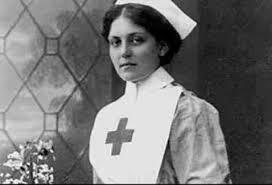
World War II also created trauma for millions of people who were forced to flee their homes. I wanted to tell the stories of some of these displaced refugees, so I created Gisela Wolff—the mysterious woman in the photograph. She and her family flee Germany aboard the passenger ship St. Louis, bound for Havana, Cuba.
 Nazi troops watching the St. Louis depart
Nazi troops watching the St. Louis departBut the ship is denied safe harbor and is eventually sent back to Europe, setting her on a perilous journey of exile and survival. You’ll have to read the novel to find out how she and Jimmy cross paths, and what ultimately happens to both of them.
There’s another character in “Long Way Home” who also has an important part to play—a stray dog named Buster. This is me with my sister’s dog, Franny, who was the inspiration for Buster.

Anyone who has ever had a pet knows how much comfort and love they offer us, and Buster plays his part beautifully in the story. And see the background scenery in this picture? The photo was taken on a pedestrian bridge that spans the Hudson River, which is the setting for “Long Way Home.” It’s also the area in New York State where I grew up.

I hope you enjoy “Long Way Home,” and that you’ll take a moment to thank a veteran for his or her service whenever you see one. And please consider making a contribution to help the many thousands of displaced refugees all around the world. I recommend “Samaritan’s Purse,” which not only offers humanitarian aid in Christ’s name, it also has an excellent program to help veterans and their families.
November 15, 2021
Can an Old Dog Learn New Tricks?
My two little granddaughters were here for a visit recently, and I couldn’t help noticing how very different the two of them are. Three-year-old Ayla is not afraid to try new things. When no one was looking, she dashed up to the top of my library ladder like an experienced fireman. She should have been afraid! We have cathedral ceilings in our living room and the bookshelves and ladder go to the very top. The rungs are steep and slippery, and I confess that my knees shake a bit whenever I need to retrieve a book from the top shelf. Ayla just laughed and did a little dance at the tippy-top, then let go with one hand to wave to us.

Five-year-old Lyla, on the other hand, never even noticed the ladder when she was Ayla’s age, much less scaled it. She’s a quiet, thoughtful child who generally doesn’t like change or trying new things. She can be adventurous once she makes up her mind to be, but she always takes a moment to stop and consider before trying something for the first time. She asked for a turn on the ladder after seeing her sister scamper up it. And she was brave enough to climb all the way to the top. But she took her time, was careful with each step, and she hung on tightly. Then she was done, and didn’t ask to climb it again.
I don’t know about you, but because of all the changes that Covid brought last year, I often found myself challenged to try new ways of doing familiar things. I would have liked to be as brave as Ayla and leap whole-heartedly into every new challenge, yet I found, like Lyla, that I don’t really like change. I often needed to be pushed or dragged or encouraged by someone more adventurous than I am before embracing something new.
This past year, I had to learn new ways to launch a book without leaving home. I learned how to research the settings of my books without traveling to the locale in person. I missed driving down to the library and wandering through the non-fiction stacks, but a very patient research librarian taught me how to navigate the internet’s endless rabbit-trails. I learned how to Zoom—and for a technophobe like me, that was like scaling a very tall ladder. Likewise, with converting my office into a recording studio to do live and recorded presentations. I learned a lot of new things the hard way, such as remembering to turn off the telephone so it wouldn’t ring during the final five minutes of my recording and force me to start all over again. And I figured out how to adjust my writing schedule and condense my usual writing style to compose something brand new for me—a novella. And a Christmas one, at that!

The Apostle Paul once claimed, “I can do everything through Him who gives me strength” (Phil. 4:13), and maybe that should be my motto in changing times. There will be occasions when I must learn to be as daring as Ayla, knowing that God will be right beside me, steadying the ladder. There will be times when I should be as cautious as Lyla, taking time to wait and pray and consider His leading. Above all, I know I can always trust the Holy Spirit to guide me as I’m led into new places.
I have one final “new thing” to share, and that’s the cover of my next novel, “Long Way Home,” which launches in June 2022.
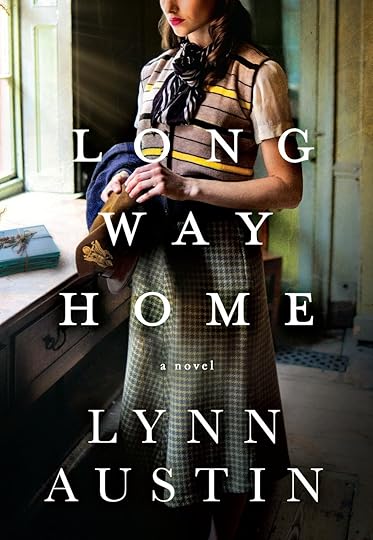
November 1, 2021
A 1951 Christmas
Good news! Only 58 days until Christmas! And if you’re looking for books to give as gifts or to get you in the holiday spirit, my first-ever Christmas novella, “The Wish Book Christmas” is now available.

If you’ve read my WWII novel, “If I Were You,” you’ll recognize the main characters, Eve Dawson and Audrey Barnett, who come to America with their young sons as British war brides. In this mini-sequel, you’ll get to read the next chapter in their lives and see what they’ve been up to since the first book ended. How are they faring in America? And did either of them ever find love again?
But I think you’ll still enjoy the Christmas novella even if you haven’t read the first book. It takes place in 1951 and starts, as the title suggests, when two kindergarten-age boys discover the Sears Christmas catalogue. They begin obsessing over this “Wish Book,” choosing dozens of toys that they want Santa to bring for Christmas. Their worried moms decide to search for ways to teach their sons the true meaning of the holiday. I know that many parents share their concern, so I hope my story will offer a few ideas to try this Christmas.
I had a lot of fun researching and writing this book. It brought back so many memories of Christmas when I was growing up. Like the boys in the novella, my two sisters and I spent many hours studying the Wish Book and choosing toys. The real catalogue from 1951 is available on the internet, and it’s still fun to peruse the pages. The cover from 1951 looks a lot like the cover of my book, don’t you think?

Here are some of the actual pages. The prices seem super-cheap:
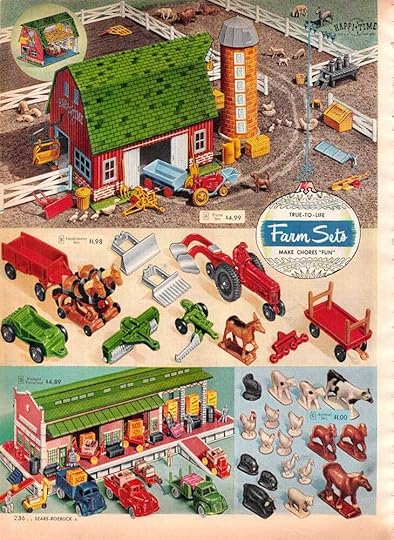

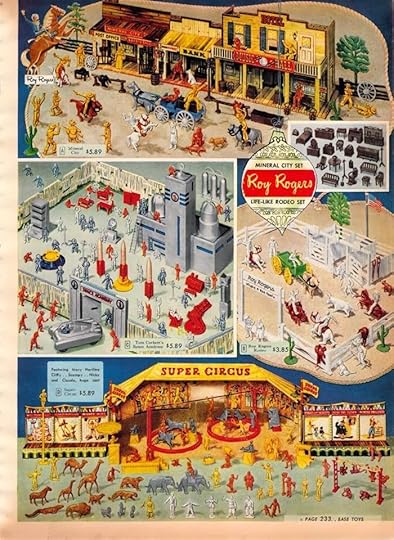
Remember when Christmas trees looked like this, with glittery tinsel dangling down? My sisters and I would drape piles of it on the tree, but I seem to recall Mom complaining that she would still be finding tinsel months layer.

Then there were those pesky strings of colored lights where if one blew out, the entire string would go out. Dad would have to test each light, one at a time, until he found the offender. And remember bubble lights?

The mothers in “The Christmas Wish Book” encourage their sons to give presents to the special people in their lives. In order to buy them, they have to earn extra money doing chores. This is something that my own parents also encouraged. We would save ten or twenty cents from our allowance each week and deposit it in a Christmas Club account at the bank. Shortly before Christmas, we would shop for presents for our parents, grandparents, and for each other using the money we’d saved.

One of the gifts that the boys in the novella want for Christmas is a dog. You’ll have to read the story to see if Santa actually brings them one. Each year, there was always one special present that I would wish for, and it would be the first thing I would search for beneath the tree. One year I wished for a doll that drank water from a bottle and then wet her diaper. I loved that doll! I kept her very well hydrated—which meant lots of wet diapers.
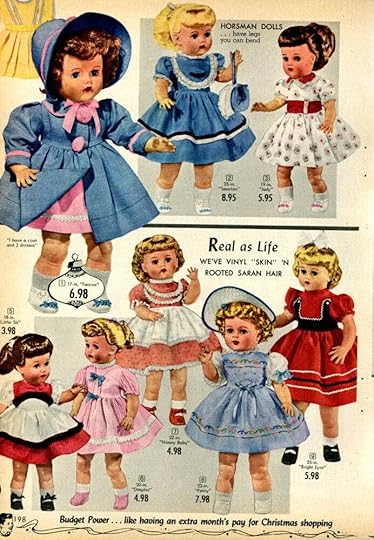
But my parents made sure that the story of Jesus’s birth was always the central focus of Christmas. We took part in pageants at school and Sunday school, sang favorite carols, and always went to the candlelight service at church. A manger scene took center stage beside our Christmas tree, and Mom read the Bible story aloud to us year after year. When my children were young, we held birthday parties for Jesus with a cake, candles and ice cream so they would know that Christmas was a celebration of His birth.

Do you remember the Christmas Wish Book from when you were a child? Was there a special gift that you wished for? I would love to hear some of your memories.
October 18, 2021
Researching?
If you’re going to write historical fiction, it helps to enjoy doing research, which I really do! This past weekend, I set out on a fun weekend with my husband, not intending for it to be a research trip. But since I can’t seem to stop looking for insights and tidbits to add to my stories, it ended up being a little bit of a research trip after all.
My husband Ken has been a car buff for as long as I’ve known him, which is more than 50 years. A few years ago, he joined The Vintage Car Club of Holland through friends of ours who own a Model A Ford. Our “not-quite-vintage-yet” car is a 2003 Mazda Miata, which still runs great at nearly 20 years old. This weekend, the car club reserved a tour bus, and about 50 of us visited several car collections, some of them private, and others, like the fantastic Stahls Automotive Collection in Chesterfield, Michigan, that were open to the public. Of course, we also laughed and dined like kings and stayed overnight in a great hotel, so all of that would have made it a fun trip. But I also learned a couple of things along the way.

First, I saw how passionate vintage car collectors are! Their enthusiasm for taking a rusted-out hulk and transforming it into a show-worthy car was inspiring. Restoring vintage cars can be a very expensive and time-consuming hobby, yet apparently addictive. Not one of the collectors wanted to stop after restoring one car. And the results were simply beautiful. Plus, they are capturing an important piece of history that shouldn’t be forgotten.

That’s the second thing I learned—a little bit about the history of the car industry. Everyone knows Henry Ford, of course, but there were many others who contributed wonderful innovations. I noticed that the earliest cars looked like carriages without the horses, hence the name “horseless carriages.”

We might still be riding in those bulky contraptions if not for engineers and designers who figured out how to streamline cars and make them more beautiful. And faster, much to the delight of Ken and his fellow Nascar fans.

Have you ever heard the expression “that’s a doozy!” Well, another thing I learned was that the expression came into use because of this car, a Duesenberg. It was such an exceptionally beautiful vehicle in its day that people would see it and remark, “That’s a Duesey!” (I love fun facts about our language!)

I enjoyed looking at all of these beautiful antique cars and imagining the characters in my books driving around in them. The novel I’m currently writing takes place in the Gilded Age when cars were just coming into use, so the timing of this trip was perfect. And the last stop on our journey just happened to be at a beautiful Gilded Age mansion in Marshall, Michigan. Look at these gorgeous hand-painted ceilings and walls! And gowns! I was in research heaven!


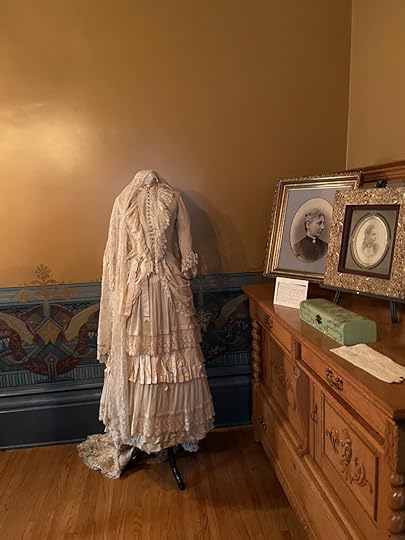

Of course, I have no idea how much of what I saw and learned will end up on the pages of my novel. Any writer will tell you that only about 10-20% of all their research ever makes it into the finished book. But our vintage car excursion has certainly helped me picture a few gorgeous settings and vehicles for when I’m creating future scenes. I hope readers will “see” them, too.

Is there a favorite time period that you enjoy traveling to through books?
Researching?
If you’re going to write historical fiction, it helps to enjoy doing research, which I really do! This past weekend, I set out on a fun trip with my husband, not intending for it to be a research trip. But since I can’t seem to stop looking for insights and tidbits to add to my stories, it ended up being a little bit of a research trip after all.
My husband Ken has been a car buff for as long as I’ve known him, which is more than 50 years. A few years ago, he joined The Vintage Car Club of Holland through friends of ours who own a Model A Ford. Our “not-quite-vintage-yet” car is a 2003 Mazda Miata, which still runs great at nearly 20 years old. This weekend, the car club reserved a tour bus, and about 50 of us visited several car collections, some of them private, and others, like the fantastic Stahls Automotive Collection in Chesterfield, Michigan, that were open to the public. Of course, we also laughed and dined like kings and stayed overnight in a great hotel, so all of that would have made it a fun trip. But I also learned a couple of things along the way.

First, I saw how passionate vintage car collectors are! Their enthusiasm for taking a rusted-out hulk and transforming it into a show-worthy car was inspiring. Restoring vintage cars can be a very expensive and time-consuming hobby, yet apparently addictive. Not one of the collectors wanted to stop after restoring one car. And the results were simply beautiful. Plus, they are capturing an important piece of history that shouldn’t be forgotten.

That’s the second thing I learned—a little bit about the history of the car industry. Everyone knows Henry Ford, of course, but there were many others who contributed wonderful innovations. I noticed that the earliest cars looked like carriages without the horses, hence the name “horseless carriages.”

We might still be riding in those bulky contraptions if not for engineers and designers who figured out how to streamline cars and make them more beautiful. And faster, much to the delight of Ken and his fellow Nascar fans. 10

Have you ever heard the expression “that’s a doozy!” Well, another thing I learned was that the word came into use because of this car, a Duesenberg. It was such an exceptionally beautiful vehicle in its day that people would see it and remark, “That’s a Duesey!” (I love fun facts about our language!) 1

I enjoyed looking at all of these beautiful antique cars and imagining the characters in my books driving around in them. The novel I’m currently writing takes place in the Gilded Age when cars were just coming into use, so the timing of this trip was perfect. And the last stop on our journey just happened to be at a beautiful Gilded Age mansion in Marshall, Michigan. Look at these gorgeous hand-painted ceilings and walls! And gowns! I was in research heaven!




Of course, I have no idea how much of what I saw and learned will end up on the pages of my novel. Any writer will tell you that only about 10-20% of all their research ever makes it into the finished book. But our vintage car excursion has certainly helped me picture a few gorgeous settings and vehicles for when I’m creating future scenes. I hope readers will “see” them, too. 5
Is there a favorite time period that you enjoy traveling to through books?
October 4, 2021
Lost!
The fall weather was beautiful last week and perfect for riding bikes. I took a break from writing one afternoon, and Ken and I rode off on one of our favorite trails. It winds through the woods north of town, away from people and traffic. Ten miles from home, we heard a woman screaming for help. An older couple running to her aid, flagged us down.
“Can you help?” they asked. “This mother has lost her little boy.”
We parked our bikes and hurried over to see what we could do. The young mother was distraught. Her son was only two. She had been doing laundry while he watched TV, and when she returned to the living room he was gone. She had left all but the screen door open on this beautiful day, and he must have wandered outside.

Ken and I and the two neighbors split up to search in all directions, calling his name. I headed behind the house and into the woods, searching through the underbrush and by every fallen tree. I prayed urgently for God’s mercy as I hurried along, asking Him to help us find this child and bring him home. Ten minutes later, with no luck, I circled back to check with the others. The little boy was still lost. His mother was now hysterical.
I understood her anguish too well. At some point in their childhoods, each of my three children had temporarily disappeared for varying lengths of time and in various places. One disappeared in a grocery store. One on the way home from school, a block away. One at the beach. They were all found, thankfully, but I will never forget the heart-stopping terror I felt. The world that swallows up your child seems so overwhelming and huge, your child, so very, very small.
Earlier that morning in my quiet time I had been praying for three family members who don’t know the Lord. I admit that my attitude toward them was not what it should be. They had hurt me badly, and I was trying to justify their behavior by thinking, “Well, what do you expect? They aren’t Christians.” But as my heart broke for that poor mother and her lost child, I caught a glimpse of God’s heart, and the grief He must feel when any of His children are lost—like my three family members. “He does not want anyone to be destroyed, but wants everyone to repent” (2 Peter 3:9).
I circled back through the woods, running faster and farther this time, calling the boy’s name. I could hear the others frantically calling, too. And I wondered, might God be asking my husband and me and anyone else who can, to search this tenaciously for His lost ones? Might He want us to set aside time from our own pleasures help seek and save more of His lost children?

With still no luck, I returned to the other searchers a second time. We needed to call the police. The elderly neighbor suggested that the mother search inside the house one last time before we called. And that’s where she found her son, fast asleep, nestled out of sight beneath a pile of clean sheets.
She came outside weeping and thanking us. I held her in my arms and felt her entire body trembling as she squeezed me tightly, clinging to me. The prodigal’s father had surely held his lost son just as tightly. As I quietly thanked God, I thought of how the angels in heaven rejoiced when one lost soul is found.
We said good bye to the others, all of us wrung out and relieved, thankful that the search had ended well. Ken and I got back on our bikes and continued on our way. And I prayed again with a new sense of urgency for my family members.



